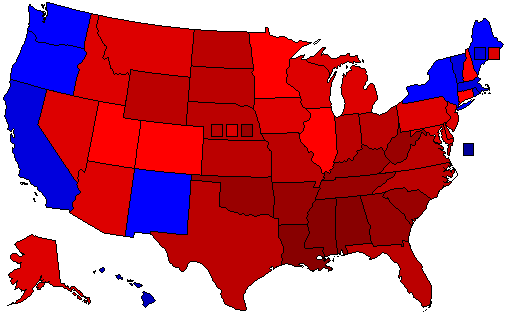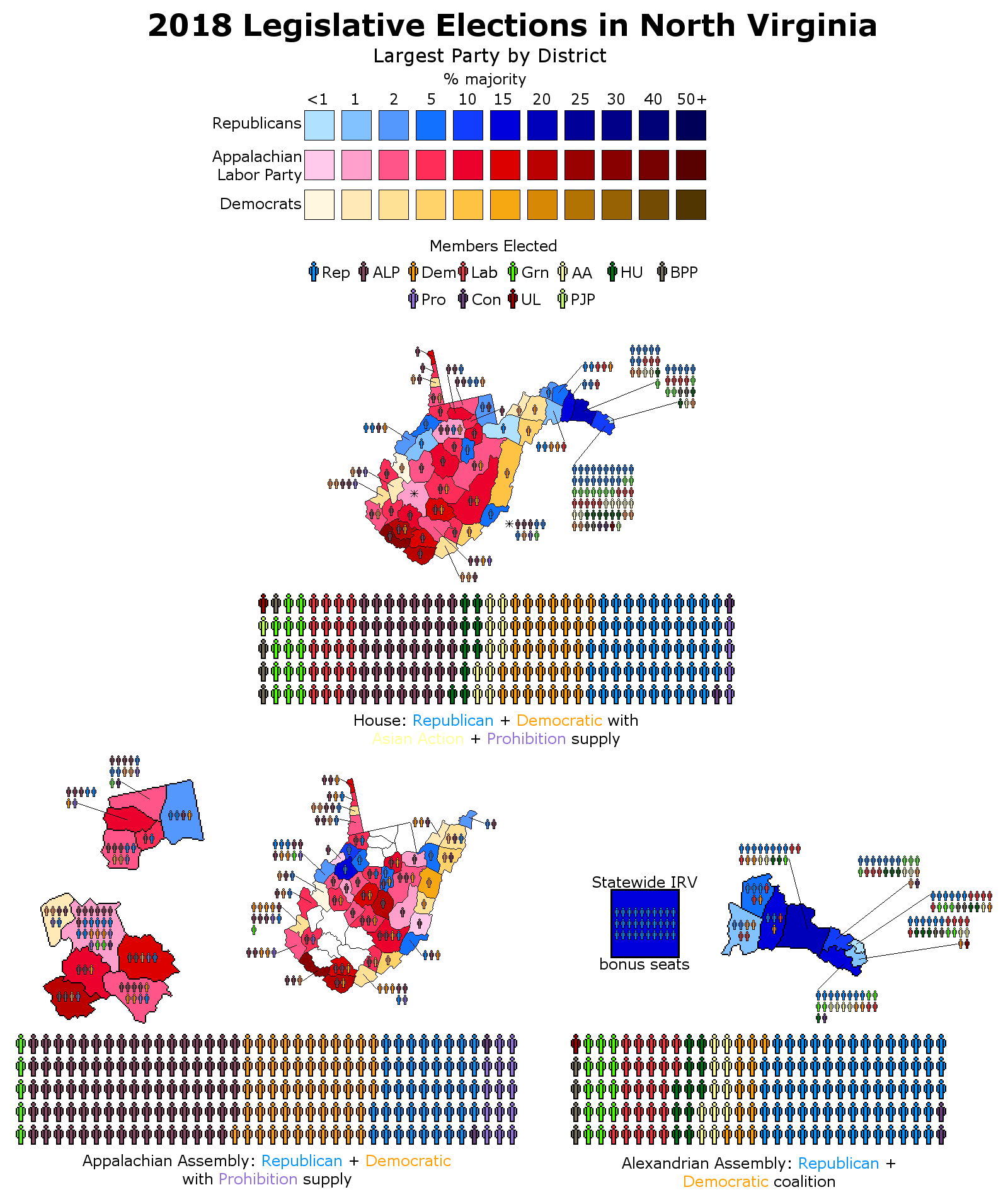The Seventh Party System: Part XXXXI
Map of the United States
Part I - Metropotamia
Part II - Alta California
Part III - North Carolina
Part IV - New Jersey
Part V - Adams
Part VI - Alabama
Part VII - Rhode Island
Part VIII - Sequoyah
Part IX - Assenisipia
Part X - East Florida
Part XI - Tennessee
Part XII - Kansas
Part XIII - Dakota
Part XIV - Arizona
Part XV - Delaware
Part XVI - Oregon
Part XVII - Ozark
Part XVIII - New Hampshire
Part XIX - Western Connecticut
Part XX - New York
Part XXI - Santo Domingo
Part XXII - South Carolina
Part XXIII - Baja California
Part XXIV - Chersonesus
Part XXV - Canal Zone Territory
Part XXVI - West Florida
Part XXVII - Missouri
Part XXVIII - Colorado
Part XXIX - Trinidad and Tobago
Part XXX - Pennsylvania
Part XXXI - Wisconsin
Part XXXII - Lincoln
Part XXXIII - Deseret
Part XXXIV - Platte
Part XXXV - Kiribati
Part XXXVI - New Mexico
Part XXXVII - Maine
Part XXXVIII - Alaska
Part XXXIX - Hamilton
Part XXXX - Mississippi
North Virginia is almost two states in one, Appalachia and Alexandria, each with their own unique, yet intertwined political system.
The state was a creation of the American Civil War, formed out the loyalist counties which succeed from the Confederacy back into the United States. As such, even back then there existed two distinct regions of the state, the Western region with its rural coal mines and the Eastern region with its bustling trading ports. Of course back then, the West was far more populated than the East, and as such the state was dominated by whoever held coal country, switching hands between first the Republicans, then Labor, and finally the National Union party.
Being under the control of Charlestown for over a century, the 1980s brought out a tremendous demographic shift as people began fleeing the Western hills for the Eastern suburbs, threatening to shift the balance of power to Arlington and Alexandria. Seeing the writing on the wall, the North Virginia Labor party took advantage of the Labor surge in 1994 surge to implement a system which they thought would keep them in the power, one state, two assemblies.
Under this principle the state would be divided into two regions, Appalachia and Alexandria, which would each elect their own assemblies. These assemblies would have a fair amount of devolved powers, however their most important power would be the ability to call a vote of no confidence on the state government. If even one of the regional assemblies successfully passed a vote of no confidence by just a 50% majority then the state House would be dissolved and new elections would be called next year. With Appalachia under the iron grip of the Labor party, the party essentially ensured that no coalition could rule the state without their permission.
In the Alexandrian Assembly Labor faced a steep uphill battle, however, with defections from both the left to the Greens and Black Panthers, as well as to the right by Hispanos Unidos. To combat this and ensure their continual supremacy the IRV bonus system was invented, with every voter getting two votes, one for their normal proportional representation seats, and a second vote where they could rank the parties. With this bonus giving the winner 30 additional seats, this winner was pretty much guaranteed to dominate the Assembly. And through constant propaganda and fear mongering about the heartless, austerity loving Republicans Labor always managed to get enough second and third preferences to come out ahead.
While Labor would manage to dominate the North Virginian political system from 1994 to 2012, national movements would bring about the beginning of the end. This national movement was the historic agreement between Labor and the Progressives for a non-competition pact, marking a sharp turn to the left from the party normally conservative social outlook. This caused massive amounts of outrage among the Appalachian section of the Labor party, which split to form its own party, the Appalachian Labor party, which would be dedicated to both social conservative and the welfare state.
With the Labor party proper now confined to Alexandria, immediate negotiations were held with the ALP to ensure that they would not call a vote of no confidence on the Labor government, demands which the ALP finally agreed to in return for increased coal subsidies.
The second crack in the system would come in 2017, with a Democratic surge putting a right wing coalition which included Hispanos Unidos and Asian Action just barely over the threshold for forming a government. However with both the Alexandrian and Appalachian Assemblies being narrowly under Labor control the two chambers immediately passed a vote of no confidence, ending this right wing coalition just as they had done three times before in 2004, 2005, and 2008.
However in this 2018 election voters were finally fed up with decades of corrupt Labor government which failed to listen to the will of the people. With a surge in support for both the Republicans and Democrats in Appalachia, and a switch of many Green voters second preferences from Labor to Republican the two assemblies were both captured by right wing governments.
While the right wing coalition alone lacked the votes to pass through constitutional amendments with support from the left wing opposition the anti-Labor forces were able to get the two-thirds majority they needed in the House to pass an amendment forever revoking not only the assemblies powers over the House but also the widely criticized IRV bonus seats. With Labor's keys to power now irrevocably dismantled the future of North Virginia looks to be a right wing one.
Government:
Republican - The party of business they home turf is the suburbs of Alexandria. While second and third preference votes from the Greens and Hispanos Unidos had kept the party out of power in the assembly for decades the new amendment removing the IRV seats makes Republican domination of the region almost guaranteed.
Democrats - A party which blends social conservatism, economic centrism, and full force racism into one potent mixture the party managed to win the best result ever in Appalachia this year, giving the right coalition the seats to oust the ALP from the assembly for the first time in its 24 year history.
Supply:
Asian Action - A centrist party of Asian Americans, they despise the Democrats too much to enter government, but are fed up enough with Labor to offer the right wing enough supply and confidence.
Prohibition - Founded in 2012 as a right wing splinter of the Constitution party by Sheriff Lowell Fellure, the party has shot up in popularity for their hard stance on tackling the drug epidemic which is currently plaguing Appalachia. Despite the fact that many are unsettled by the rumors of how Fellure ran his county police force more like a death squad their votes were easy bought by the Republicans and Democrats in return for the creation of a multi-million dollar drug fighting task force, which is authorized to shoot first and ask questions later.
Opposition:
Appalachian Labor Party - A right wing splinter of the Labor dedicated to social conservatism and the coal industry they completely dominated Appalachia's assembly up until this year's election, and now have to contend with being in the opposition.
Labor - The twin party to the ALP, their base is considerably more diverse and socially liberal, though not the extent of the Greens. Beholden to the interests of national labor unions, the party had become infamous in North Virginia for their corruption, but this year was the first one in which enough voters dared to rank the Republican above Labor.
Greens - Often having to play the uneasy role as Labor's partner in both the Alexandrian assembly and the state House, the party was finally fed up with Labor and turned to the Republicans in this year's election. And while the party is applauding the Republicans' repeal of the IRV seats some of its members have begun to bring attention to the issue of the Prohibition, whose hardliner anti-drug stances have just been fully funded by the GOP.
Hispanos Unidos - A party for centrists Hispanics, they gained a fair number of seats from those who were fed up with Labor and wanted a change, though Prohibition being a part of the government's supply was not exactly the change they had in mind.
Black Panther Party - A party for black supremacists, they continued to gain strength in North Virginia just as they have in many other states, and their abstentions on the IRV vote contributed to Labor's historic loss.
Constitution - The party of the religious right, they have been largely overshadowed by the much more radical Prohibition party but still hold some support among those who don't go as far as Sheriff Fellure.
United Left - An alliance of far-leftists from democratic socialists to outright communists their seat in the North Virginian house is mainly due to the low thresholds which exist in the massive electoral district of Fairfax County.
People's Justice Party - A party for Muslim Americans, they gained a seat for the first time in 2016 and have increased their vote share slightly in 2018 as the Labor party continues to bleed its ethnic voters.
Credit for the basemap goes to Chicxulub.

